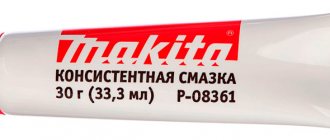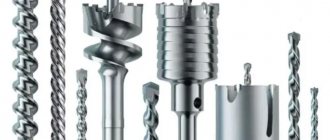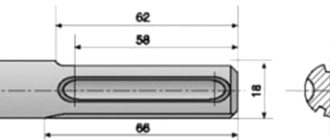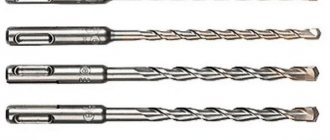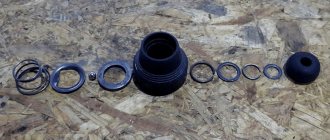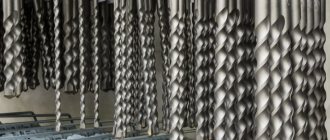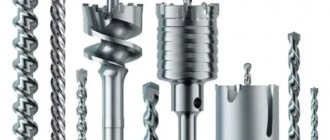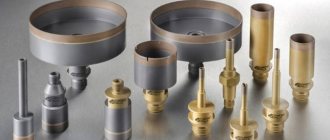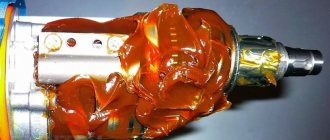Drill hole: features
Drills are used exclusively for working with a hammer drill. They are not used for drills. There are a number of different types of drill bits available, depending on the material you plan to work with. Metal, masonry and wood can be drilled using specially designed structures. They are adapted to the properties of a specific material and will help achieve the desired result with minimal effort and time. The range of drills also includes special products, for example for creating holes in glass surfaces or tiles. For these purposes, manufacturers produce drills with diamond tips made of tungsten carbide.
The quality of drills is determined by the material from which they are made. Accordingly, the type of material that they can drill is determined. Most often, drills are made from materials such as high-speed steel, with the addition of carbide, titanium, cobalt and other substances that improve the properties of the material.
Drills differ in the type of shank. Thus, straight shanks are used for chucks with and without a key for holes with a diameter of 10-13 mm. SDS shanks are used for corresponding rotary hammers. Hex shanks are used for screwdrivers.
Drills for stone and metal can be spiral-shaped, drills for wood can be twisted or flat. Drills come in different diameters and lengths. Extensions can be used if necessary.
Concrete drill SDS-plus S4 (4x50/110 mm) Kraton – best price
A cutting tool equipped with a tip made of a composite cermet alloy easily overcomes resistance in a layer of concrete and brick. This is facilitated by a durable carbon steel body, made of one diameter along the entire length.
Pros:
- Affordable price, best for the standard size.
- Durable rod.
Minuses:
- Lack of protective coating - the body begins to rust in an environment with high humidity
How to choose metal drills?
To start working with a drill, you need to determine the characteristics of the metal that you will drill. All metals have different levels of density. The density of the metal determines the design of the drill, as it must be harder than the metal into which it is pointed.
Manufacturers take this rule into account, so they are made from different materials containing different elements to increase hardness and improve cutting ability. Conventionally, there are two groups of metal drill materials:
- made of high-speed or alloy steel: it is an alloy consisting of a metal element combined with a chemical element that gives the steel certain properties;
- made of hard metal or carbide. powdered forms of tungsten carbide are heat treated with binder metals such as titanium or cobalt to produce a solid.
Drill SDS-plus PRACTICE Pro 915-763 20 x 1200 mm
Photo: market.yandex.ru
Drill bit for hammer drill Practice 915-763 is an indispensable accessory for impact drilling, which is designed for use in lightweight models of rotary hammers with support for the SDS-plus fastening system. The equipment is securely fixed in the tool chuck and does not fall out of it even under the highest drilling loads. The diameter of the drill is 20 mm, and its total length is 1200 mm, which allows you to make fairly deep holes. Before using the drill, it is necessary to pre-drill the material with a smaller diameter drill.
Drill SDS-plus PRACTICE Pro 915-763 20 x 1200 mm
Advantages:
- Effective in drilling concrete structures
- The drill is based on a carbide plate
- Capable of withstanding high drilling loads
- Single spiral effectively removes drill chips
- The drill rod moves quickly inside the material
- A-type spiral ensures uniform load on the body of the equipment
- Minimum vibration strength
- High speed
Popular types of metal drills
Drills are classified by type, cutting method, and connecting element. The following types of drill according to the material used are available on the market:
- made of high-speed steel. The most popular steel, characterized by high hardness, strength and sharpening ability;
- from colbate. provides strength and resistance, increases the hardness of the drill. Cobalt retains its properties better at higher temperatures than titanium, so a higher operating speed of the hammer drill is acceptable;
- titanium. Titanium coated drill bits provide a stronger and more stable alloy. When choosing titanium drills, pay attention to the percentage of the auxiliary component;
- Wolfram carbide. This component gives drills an increased level of strength and hardness. The combination of tungsten and carbon produces a harder or softer metal depending on the percentage of carbon in it.
Drill bits should be used with cutting fluid at low speeds using even and constant pressure. Monitor the condition of the crown, which should always be sharpened. If the drill is used incorrectly, it will quickly become unusable.
With different ratios of components in the mixture, metals with different properties are formed. A low percentage of impurities will have little effect on the quality and durability of the drill. The quality of the drill is also influenced by its processing and production processes.
The drill hardness rating is determined using the Brinell scale. The indicators are determined in newtons per square millimeter. A higher indicator means a more stable and reliable drill.
Types of nozzles and drills - which manufacturers are better
It is recommended to give preference to branded working equipment from Bosch, Metabo, Makita. Replacement parts from these manufacturers not only last a long time, but are also less likely to damage tools and surfaces.
Types of tips (carbide cutting inserts) of drills
Let us examine in more detail the types of working removable elements of electric hammer drills.
Screw attachments
They are used when you need to create deep holes. The spiral design ensures efficient dust removal, which reduces work time.
Flat drills
They come in handy when you need to make a small hole. They are durable, but inconvenient for long-term use: due to poor debris removal, the user has to manually remove dust from the resulting hole.
Spiral drills
They are best suited if you need to drill through a thick wall: the design will ensure high-quality and timely removal of construction waste.
Drill bit
Crowns
Used in electrical installation work. Necessary when you need a hole for a socket or switches. There are crowns with diamond coating or pobedit teeth.
Other types of drills
There are varieties of attachments that are useful in certain specific situations:
- A drill with a high flute angle produces deep holes at high speeds that wear out quickly, putting a lot of stress on the power tool.
- A low flute angle bit will quickly drill a large number of small holes.
Creating holes with drills in stone and concrete
When choosing a drill bit for a stone hammer drill, it is not so difficult. It is important to determine how soft or hard the material needs to be drilled. Most rock drill bits are made from tungsten carbide.
Tungsten carbide drills are effective on concrete, granite, silicate masonry and natural stone. The overall quality of concrete drills depends on the quality of their tip and the number of cutting edges - 2,3,4.
The most effective will be a drill with four cutting edges made of carbide. Less durable drills have no more than 2 edges. Reinforced concrete must be hammer drilled using a standard or impact drill.
For concrete work, drills with the following types of shanks are used:
- straight shank;
- Slotted Drive SDS: A drill with a knurled shank that snaps into the chuck. Used in most hammer drills;
- hexagonal. More suitable for screwdrivers. These drills are designed for use with impact-type screwdrivers
Most concrete drills have SDS+ shanks. SDS Max shanks are used for heavy duty applications.
To work with a stone drill, various product designs are used. They most often differ in the type of groove. There are: a double L-shaped groove - this is a universal option, a U-shaped one - for better chip removal, with four teeth - to increase the stability of the drill. Grooves differ in the number of edges.
Drill and drill. What is the difference?
A drill is a tool that is an accessory of a drill. The main purpose of a drill is drilling. Although there are devices that have a striking function, this is in addition to drilling. In a rotary hammer, on the contrary, the first place is given to the function of impact and crushing of material, which is complemented by the possibility of rotation. The accessories for these two tools are similar in appearance, but they can be interchanged. This is due to the fact that the drill in the hammer drill does not have a rigid mount for quick change of equipment. And the drill has a jaw chuck, and there is a rigid fastening here.
Now let's look at the differences in the design of these two tools. The drill shank is a smooth surface with a simple shape. And the drill shank has the shape of a cylinder with protrusions and recesses, which is called SDS-plus and SDS-max. The grooves of the drill have a sharp edge, with their help they cut holes in the material being processed. This design for hammer drills is designed to remove residual material. Drills also differ in their design according to their purpose for a specific material. For example, drills for metal have different head sharpening angles, and for working with wood, the tool has a self-centering head.
Creating holes with a drill in wood
Most wood drill bits are made from hardened steel. There are several types of drills for wood processing:
- flat drills are used for drilling large diameters over 13 mm;
- spiral drills are supplied with a diameter of up to 17 mm, although there are exceptions;
- auger drills designed to remove chips when drilling wide holes;
- Triangular drills are suitable for drilling small holes.
Spiral drills are more suitable for working with denser materials, flat drills for smaller ones. Drills have different types of shanks. The straight shank is considered the most versatile.
Concrete drill (5x50/110 mm) SPEC-0210002 – optimal for domestic purposes
Used for drilling holes with a diameter of 5 mm in structures made of dense and hard concrete and ceramic bricks. Optimal sharpening of the tungsten carbide tip increases the accuracy of work and extends the life of the cutting tool.
Pros:
- Price in its segment.
- Good drilling speed for a household drill.
- Thermal hardening of the entire tool.
Minuses:
- Quickly dulls when in contact with metal embedded parts and fittings.
How else are there drills?
In addition to the most popular types of borom, there are other types. They will be useful for effectively solving specific problems. The list of universal drills for metal, concrete, and wood is supplemented by the following types:
- stepped drills – conical-shaped products with different diameters;
- short drills - for drilling very hard metals and spot welding;
- Forstner drills - for drilling large holes;
- sliding drills – suitable for creating holes in wooden structures. Available in diameter sizes from 13 to 45 mm;
- drills with countersinks - for creating new holes with a drill or working with thin materials, for example, chipboard;
- installation drills are long products designed to create holes for pulling wire.
Drill SDS-plus (10 mm, 50/110 mm) Enkor 10905 – availability
Ideal for drilling holes in concrete, brick and stone during household work. The rod is equipped with spiral grooves for removing sludge. The surface of the rod is subjected to additional compaction.
Pros:
- Inexpensive.
- Widely represented on the market.
Minuses:
- Weak when encountering hidden metal structures.
Drilling with a rotary hammer
A hammer drill is one of the most important power tools in the repair industry. Without it, it is difficult to imagine major repairs and solving everyday problems. When choosing a rotary hammer, it is important to pay attention to several factors that determine the quality and efficiency of its operation.
If you are looking for a rotary hammer, first, better determine its technical and mechanical features:
- Hammer Size: Determines the size of drill bits you can use with this tool. The larger hammer drill is designed for industrial projects, while the smaller hammer hammer is typically used at home.
- Motor Speed: The motor speed of a hammer drill determines the power of the motor. A faster spinning motor usually results in higher hammer drill performance. The description of the hammer drill should contain information about the number of revolutions per minute.
- Motor power: It is imperative to check the motor power of the rotary hammer before purchasing. Like various other power tools, the motor power of a hammer drill is usually specified in amps. Universal size - 6 or 7 amperes.
- Durability and build quality. The high-quality plastics and metals used to make the hammer drill allow it to last a little longer.
- Type of food. Although all hammer drills are electric, they may use a different method of power delivery. Most popular impact drill options are corded hammer drills that charge by plugging into an outlet. Another method is battery power. This tool can be used regardless of the power source.
An advantage when choosing a hammer drill is the set of drills included. Different drills are suitable for specific conditions and applications. The hammer drill may also be sold with a carrying case. It will come in handy when using the tool.
Drill bit for rotary hammers (6x50/110 mm) P4Plus Metabo 626204000 – versatility
The drill belongs to the universal class - in addition to concrete, brick and rocks, the tool goes through a certain thickness of metal. This is facilitated by the main and side cutting edges. Compliance with technological rules during assembly made it possible to increase the accuracy of passage and reduce friction. The drilling flour is effectively removed by the special geometry of the spiral groove.
Pros:
- Excellent workmanship.
- Withstands contact with metal parts.
- Strengthening the rod.
Minuses:
- Perhaps the price. But it is justified by technical capabilities and long-term operation.
Review of the best drills for rotary hammers 2022
- Bosch 2608833778. This product is suitable for working on hard surfaces. It is used for rotary hammers with an SDS-plus chuck. This model is equipped with a reinforced tip, which provides a centering position when drilling. The manufacturer wisely approached the shape of the head, making it asymmetrical. Due to this, less dust is generated during the drilling process.
During operation, the drill withstands any manipulation and is considered wear-resistant. The drill also contains four edges responsible for cutting the material. They are located in such a way that the drill will not jam in the hammer drill. High-strength carbide and tungsten are used to produce drills. This composition is responsible for wear resistance and impact resistance. The benefits of products from a well-known brand will be guaranteed for the entire operational life of the product. Such drills cost around 160 rubles, so the only downside is their price.
- Makita D-00050 is compatible with SDS-plus type chucks. The average price on the market is around 80 rubles. The cost is quite justified. The design has two cutting edges. Due to this, the drills take a little longer to make a hole than the previous model. Despite this, the drill is quite functional, and the drilling itself proceeds without delay. The tip is weighted due to its pointed shape. Therefore, you can count on drilling in a given direction. No vibration will be felt while working with the drill. This version of the drill is suitable for working with materials of increased hardness, such as concrete, brick or stone.
- DeWalt DT9571-QZ 14 costs around 600 rubles. The main feature of the drill is increased strength due to the reinforced core structure inside. There are several advantages of the drill:
- Excellent carbide alloy for long life and better strength;
- optimized groove design to eliminate debris and formed chips;
- hardened case for added strength and reduced risk of breakage;
- 160 degree tip design provides better penetration, increased drilling speed.
The drill is suitable for models with SDS-plus chucks. This is an example of a modern drill with excellent mechanical properties.
- ZUBR 29380-340-12 is a product adapted for working with SDS-max rotary hammers. The domestically produced drill has a screw spiral. It provides increased space through which dust is removed. Durable steel is used to produce the drill. The tip has two cutting grooves. This is the standard option. The advantage of the drill will be the presence of a reinforced core. Minimal vibration during operation and extended service life attract buyers. When used in a hammer drill, jamming of the drill is excluded.
- Granite 425100. Drills of this model are compatible with hammer drills with SDS-plus cartridges. The presence of four cutting edges made of carbide and tungsten provides increased wear resistance of the drill. The issue of dust formation and edge accumulation was resolved thanks to the double helix. It also guarantees increased operating speed of the tool. Alloy steel is used to produce drills. Granite drills are suitable for working with all types of concrete and brick. According to customer reviews, this model is not always found in stores. Overall, the drill is worth its price and is considered a popular model with a good service life.
- DeWalt Extreme Kit. The drill bits in this case have No-Walk tips for clean, precise drilling. High quality work is achieved thanks to recessed cutting wings. They are suitable for drilling alloy and non-alloy steel, and can be used to create holes in wood and plastics, thin metals and sheet metals. The set includes 6 Extreme drills and 11 drill bits for screwdrivers and 2 holders for quick drill replacement. The cost of the case is 2300 rubles including a suitcase made of high-strength plastic.
Best Inexpensive Drill Sets
Budget drills are presented with no less high-quality products, but, as a rule, in reduced configurations .
Makita D-00795
Using the SDS-plus Makita D-00795 kit, supplied in a convenient blister, you can quickly and easily make a hole of any diameter in concrete or masonry.
The presented set is equipped with five high-strength drills.
Each product is made of a special alloy and has an optimal centering tip geometry, guaranteeing accurate and fast drilling.
The convenient shank provides ease of installation, versatility and compatibility with many well-known hammer drills.
The dust removal spiral with four-groove thread ensures rapid removal of cuttings from the drilling zone. This technology speeds up and facilitates the work process.
Characteristics and equipment:
- working part - drill;
- shank - SDS-plus with a diameter of 10 mm;
- number of items in the set - 5;
- processed materials - concrete, brick;
- set of drills - 5×110/6×110/8×110/6×160/8×160 mm;
- Features: plastic blister packaging.
Advantages
- reasonable price;
- quality steel;
- there is lubricant from the factory;
- compactness for storage.
Flaws
- primitive packaging;
- limited selection of rooms;
- lack of long equipment in the set.
Metabo 626243000 160 mm
The SDS-plus Metabo 626243000 set with 160 mm long accessories is suitable for use in rotary hammers when drilling materials such as brick or concrete.
The drill bits used in the kit are the most common with guaranteed compatibility with most models of rotary hammers from different manufacturers.
The set contains five items - these are drills with a diameter of 5 to 10 mm.
The elements are made of high-quality steel, contain a tip made of hard alloys, which easily passes through dense materials and withstands long-term use.
The spiral is made in the shape of the letter S for faster removal of generated debris during drilling.
Characteristics and equipment:
- working part - drill;
- shank - SDS-plus with a diameter of 10 mm;
- number of items in the set - 5;
- processed materials - concrete, stone;
- set of drills - 5×160/6×160 ×2/8×160/10×160 mm;
- Features: plastic case for storing equipment.
Advantages
- ideal for domestic use;
- affordable price tag;
- high-quality equipment;
- Convenient case included.
Flaws
- no long drills;
- The case gets dirty quickly.
ELITECH 1820.036600
The SDS-plus ELITECH 1820.036600 set is ideal for making holes in concrete materials using a hammer drill with the appropriate type of fastening.
The presented kit is equipped with elements with an SDS-Plus shank - the most popular equipment base option, compatible with most modern rotary hammers.
The plastic case contains five drills with a diameter of 5 to 10 mm and a length of 110 and 160 mm.
The equipment is distinguished by excellent workmanship and a high degree of reliability.
Characteristics and equipment:
- working part - drill;
- shank - SDS-plus with a diameter of 10 mm;
- number of items in the set - 5;
- processed materials - concrete;
- set of drills - 5×110/6×110/6×160/8×160/10×160 mm;
- Features: Plastic storage case.
Advantages
- low price;
- main numbers in the set;
- there is a case for storing equipment;
- Ease of use.
Flaws
- The case cover is not very reliable;
- there is a smell of plastic;
- Medium length rigs only.
BOSCH 2608833912 160 mm
Using the SDS-plus BOSCH 2608833912 160 mm set, designed to work with concrete, brick or stone in hammer drilling mode, the user will be able to make clean and neat holes in dense materials.
Drills of the same length have diameters of 6, 8 and 10 mm.
The equipment is suitable for construction, finishing and installation work.
Suitable for use in household and professional hammer drill models.
Three complete products are placed in plastic packaging.
The SDS-Plus type shank guarantees reliable fixation in the power tool chuck.
The spiral-shaped working part of each drill effectively removes dust from the hole being made and does not heat up during operation.
Characteristics and equipment:
- working part - drill;
- shank - SDS-plus with a diameter of 10 mm;
- number of items in the set - 3;
- processed materials - concrete, brick, stone;
- set of drills - 6×160/8×160/10×160 mm;
- Features: plastic packaging, centering tip.
Advantages
- ease of drilling even with a weak impact;
- the most common drill diameters included;
- high quality of materials and workmanship;
- price corresponding to quality.
Flaws
- no case included;
- The packaging is poorly suited for storing equipment.
Drills for rotary hammers: what you need to know about their use
Despite manufacturers' claims about the durability of drills, they can fail. Most often, the period of use depends on the materials with which it comes into contact. The cause of a drill malfunction may also be considered to be improper use. Also, the owner of a hammer drill should not forget about the mandatory lubrication of tools.
The drill is practically not subject to restoration and repair. This is a consumable item, so it will be easier to buy a new drill. During the working process, the drill does not need to be removed from the hammer drill and cooled. There will be no overheating, and the drill itself heats up to a temperature that it can withstand.
Choose high-quality drills and use them for the specified purposes.
Fixation in the chuck
The most basic thing you need to understand when buying a drill is the types of shanks. After all, inexperienced craftsmen have situations when, after purchasing a drill, it turns out that it does not even fit the tool. You have to go back to the store and exchange for another one.
For a better understanding, let’s look at each type of SDS system[1]:
SDS-plus - most household hammer drills are equipped with this chuck. This type is intended for shanks of the same name, the diameter of which does not exceed 18 mm. The tool is securely fixed thanks to 4 grooves, two of which are responsible for locking the drill in the chuck, and the other two set the exact direction of movement during impact impulses.
SDS-top has almost no differences from the pluses, but it performs better when drilling holes larger than 16 mm. The drill is fixed in a similar way, but lies deeper into the tool, which increases the contact area. This cartridge almost always comes with a smaller plus version.
SDS-max is designed for more serious tasks. However, such a cartridge is found only in professional series of hammer drills and is rarely used in everyday life. A drill for such a tool can exceed 18 mm in shank diameter. The structure of such a shank is similar to SDS+, but has additional grooves for energy transmission.
SDS-quick is only used in some Bosch rotary hammers. This chuck is considered universal and is capable of fixing hex bits and drills, in addition to drills. However, it is intended for small diameters and is used only in everyday life.
There is also a cam adapter for the hammer drill . It allows you to use a hammer drill, which has a drilling mode without impact, with cylindrical drills and even bits for screws. This chuck is useful when you don’t have a drill at hand, but there is an urgent need to drill a hole in wood, metal, etc.
[1] S pecial D irect S ystem - “special guide system.” Invented and created by Bosch to make it easier to remove tools from the chuck.
Bur: purpose
Drills and drills are consumables, but their importance in the design is high. The element is a impact-cutting element. Novice builders sometimes confuse this product with a drill, but there is a big difference between the two.
The drill is made from alloy steel, but also has diamond brazing. This solution will increase service life and wear resistance. It has a tail part where special grooves are located, a spiral rod and a cutting part. Just like a drill, it is installed in a hammer drill chuck. We must not forget that the drill is a consumable item and is often used to create holes in a concrete or stone wall. The product should not be used on metals or wood as it is not intended for this purpose. For such purposes, it is worth purchasing the appropriate tools.
Drills are sold in different lengths and diameters. If a person is looking for an option for use at home, then a good solution is 6-10 mm. In this case, it is necessary to select a dowel that is suitable for these sizes. The maximum diameter is 5 cm. In the professional sphere, builders use material with a length of from 10 to 100 cm. It is important to understand that when making technical holes, compliance with the diameter and length is a mandatory requirement. This is the only way a person will ensure the greatest efficiency and durability of the nozzle.
A drill is not a drill
In terms of external signs, these elements have a minimum of differences, which is why an ignorant person may get confused and buy the wrong option. In addition, their purpose is also the same - creating holes. The only difference is that the drill is designed to work with plastic, wood and metal, but the drill is used only for concrete or brick surfaces. Often, because of this ignorance, people buy a standard drill, and when they get home they immediately break it.
The drill is many times stronger than a conventional element, and also has a larger size and diameter. The maximum cross-sectional value of the drill is 14 mm; for impact-cutting products this figure reaches 55 mm. In addition, the design of the shank differs. So the drill has special grooves, while the drill does not.
The product is used in every hammer drill, even hammerless ones, but it is not intended for use in a drill. Some drill models are manufactured with multiple cutting inserts and may also have a special geometry that holds it securely in the center of the hole. Also, impact cutting tools are durable, but the price of this product is several times higher.
How to care for a drill
The most common cause of tool failure is dust. It penetrates inside the cartridge, causing excessive friction of parts, overheating of the mechanism or its unstable operation. Of course, each unit has its own resource, but with proper care it can be extended. It is important to know whether and how often it is necessary to lubricate and cool the hammer drill, what is the permissible drilling time, etc.
There are a number of rules that will allow you to operate the device for a long time:
- You should not put your weight on the tool when drilling - this does not increase its productivity;
- Leaving the unit running idle means forcing it to absorb energy in its own body, which leads to rapid wear;
- It is better to drill particularly hard surfaces with special lubricant and liquid cooling;
- If you need to drill deep holes, then it is better to start with short drills, gradually replacing them with longer ones;
- The shank should be lubricated every 1000 holes. Owners often ask: How and with what to lubricate a hammer drill? In any case, you must first remove the accumulated dust and wipe it dry. It is better to use branded lubricant, but you can also take a more budget-friendly grease or lithol;
- If you work with a tool all day, you should take regular breaks to cool the drill bits in machine oil or water. And the device needs cooling;
- Be sure to stop drilling if the housing gets hot. Experts advise: drill for 30 minutes, cool the tool for 10 minutes.
Before you start: How to work with a hammer drill: 7 nuances that are important to know
